Wine is a world of discovery, offering endless variety and the chance to enhance life’s experiences. This beginner’s guide simplifies the journey into wine, making it accessible and enjoyable for newcomers.
1.1 What is Wine and Why Explore It?
Wine is a crafted beverage made from fermented grapes, offering a diverse range of flavors, aromas, and textures. Exploring wine opens doors to new sensory experiences, cultural insights, and social connections. Whether you enjoy it on its own or paired with food, wine enhances moments, fostering appreciation for craftsmanship and tradition. For beginners, discovering wine is a journey of curiosity and delight, where each sip reveals stories of terroir, history, and passion. Embracing wine invites you to explore its vast possibilities, from crisp whites to bold reds, and uncover the joy of savoring life’s simple pleasures.
1.2 Benefits of Learning About Wine
Learning about wine offers numerous rewards, from enhancing social experiences to deepening culinary enjoyment. Understanding wine fosters confidence when selecting bottles, navigating restaurant menus, or engaging in conversations. It also enriches dining experiences by revealing how wines complement or contrast with various cuisines. Beyond practical benefits, exploring wine cultivates an appreciation for craftsmanship, cultural traditions, and the artistry behind winemaking. This knowledge not only broadens personal horizons but also enhances life’s everyday pleasures, making every sip a story of discovery and connection.
Understanding Wine Basics
Exploring wine basics reveals a world of variety, from types like red, white, and sparkling to grape varieties and regions, guiding you through labels and more.
2.1 Types of Wine: Red, White, Rosé, and Sparkling
Wine is categorized into four main types: red, white, rosé, and sparkling. Red wines, like Cabernet Sauvignon and Pinot Noir, are bold and full-bodied, with tannins adding complexity. White wines, such as Chardonnay and Sauvignon Blanc, are typically lighter, offering crisp acidity and fruity notes. Rosé wines are refreshing, with a pink hue and flavors of berries and citrus. Sparkling wines, like Champagne and Prosecco, add effervescence, perfect for celebrations. Each type offers unique characteristics, catering to diverse palates and occasions, making wine exploration endlessly exciting for beginners and connoisseurs alike.
2.2 Major Grape Varieties: Chardonnay, Cabernet Sauvignon, and More
The world of wine is shaped by its grape varieties. Chardonnay, a popular white grape, produces buttery, oaky wines, while Cabernet Sauvignon, a red grape, is known for bold flavors of dark fruit and spice. Pinot Noir, another red variety, offers light-bodied wines with delicate notes of cherry and earth. Sauvignon Blanc and Pinot Grigio are crisp white grapes, perfect for beginners. These varieties form the foundation of many wines, each offering unique taste profiles that cater to different preferences, making them essential to explore for anyone starting their wine journey. Understanding these grapes helps in selecting wines that suit personal tastes and pairing them with various dishes.
2.3 Differences Between Old World and New World Wines
Old World wines, primarily from Europe, emphasize tradition, terroir, and subtlety. Regions like Bordeaux and Burgundy focus on balanced acidity and tannins, often with earthy, mineral notes. New World wines, from areas like California and Australia, highlight fruit-forward flavors, richness, and approachability. They tend to be bolder and more full-bodied, with oak influences. While Old World wines may seem complex, New World wines are generally easier for beginners to enjoy due to their straightforward fruitiness. This distinction helps guide choices, whether seeking classic elegance or modern vibrancy, making both styles appealing in their own right for different occasions and palates.
2.4 Understanding Wine Labels: Regions, Vintage, and More
Wine labels are packed with information, but they can be overwhelming for beginners. The region indicates where the grapes were grown, which affects the wine’s style and quality. The vintage refers to the year the grapes were harvested, with some years being better than others due to weather conditions. The grape variety or blend is often listed, helping you identify the wine’s flavor profile. ABV (alcohol by volume) shows the wine’s strength, while terms like “Reserva” or “Grand Cru” indicate aging or quality levels. Understanding these elements helps you make informed choices and appreciate the craftsmanship behind the wine. Start by focusing on regions and varieties you enjoy!

How to Taste Wine
Mastering the art of wine tasting involves a 6-step method: swirl, sniff, sip, savor, spit, and note. This process reveals a wine’s complex notes and flavor profile.
3.1 The 6-Step Wine Tasting Method
Mastering the 6-step wine tasting method is essential for beginners to fully appreciate a wine’s qualities. Start by pouring a small amount into a clean glass. Swirl the wine to release its aromas, then sniff to detect its bouquet. Next, take a small sip and let the wine coat your palate. Savor the flavors, paying attention to sweetness, acidity, and tannins. Finally, spit or swallow, and note your impressions. This systematic approach helps beginners evaluate and enjoy wine more thoughtfully.
3.2 Understanding the Four Key Factors: Sweetness, Acidity, Tannins, and Body
When tasting wine, four key factors define its profile: sweetness, acidity, tannins, and body. Sweetness refers to the wine’s residual sugar, ranging from dry to dessert-like. Acidity adds brightness and balance, with higher levels creating a crisp, refreshing feel. Tannins, naturally occurring compounds, contribute a drying sensation and structure, often found in red wines. Lastly, body describes the wine’s weight, categorized as light, medium, or full-bodied. Understanding these elements helps beginners describe and differentiate wines, enhancing their appreciation and pairing abilities. These factors work together to shape the wine’s overall character, making each sip a unique experience.
3.3 Common Wine Vocabulary for Beginners
Mastering basic wine vocabulary helps beginners communicate effectively about their experiences. Terms like crisp and smooth describe texture, while fruity and earthy define flavors. Words like oaky and buttery often describe wines aged in barrels. Body refers to a wine’s weight, from light to full-bodied. Understanding phrases like well-balanced or finish enhances your ability to describe and appreciate wines. These terms form the foundation for discussing wine, making the journey more enjoyable and social. Learning this vocabulary empowers beginners to confidently share their impressions and explore the world of wine with clarity and enthusiasm.
Choosing the Right Wine
Selecting wine can be straightforward once you consider personal taste, occasion, and budget. Start with approachable varieties like Pinot Grigio or Merlot for a seamless experience.
4.1 Best White Wines for Beginners: Pinot Grigio, Chardonnay, and More
White wines are an excellent starting point for newcomers due to their approachable flavors. Pinot Grigio, with its crisp acidity and citrus notes, is a popular choice. Chardonnay offers a creamy texture and hints of vanilla, appealing to those who prefer richer styles. Sauvignon Blanc dazzles with its vibrant fruitiness and refreshing zing. For a lighter option, Vinho Verde from Portugal provides a delicate and slightly fizzy profile. These wines are designed to be smooth and balanced, making them ideal for beginners exploring the world of white wines. Each variety offers unique characteristics, ensuring there’s something for every palate.
4.2 Best Red Wines for Beginners: Pinot Noir, Merlot, and More
Red wines can seem intimidating, but certain varieties are perfect for beginners. Pinot Noir stands out as a light-bodied option with flavors of cherry, raspberry, and subtle earthy notes, making it approachable and versatile. Merlot offers a smoother profile with plum and chocolate hints, appealing to those who prefer less acidity. Cabernet Sauvignon, while slightly bolder, introduces tannins gently, making it a great transition wine. Other excellent choices include Beaujolais, known for its fruity and light style, and Dolcetto, offering bright acidity and moderate complexity. These wines are designed to be accessible, allowing newcomers to explore the diverse world of red wines with ease and confidence;
4.3 How to Read a Wine Label and Understand Its Contents
Wine labels are designed to inform and guide consumers, but they can be confusing for beginners. Start by looking for the region, which indicates where the grapes were grown, as this often reflects the wine’s style. The vintage (year) is important, especially for red wines, as it can affect quality and aging potential. Check the grape variety or blend, as this determines the wine’s flavor profile. Other key elements include the producer (winery) and alcohol content. Some labels may also feature awards or certifications. Understanding these basics helps you make informed choices and enhances your wine-drinking experience. Always look for clarity and consistency in the information provided.
4.4 Wine Regions and Their Specialties
Exploring wine regions is essential for understanding their unique offerings. France is renowned for Bordeaux’s bold reds and Burgundy’s Pinot Noir and Chardonnay. Italy boasts Tuscany’s Chianti and Piedmont’s Barolo. Spain offers Rioja’s Tempranillo, while Germany excels in Riesling. New World regions like California, famous for Napa Valley’s Cabernet Sauvignon, and Argentina, known for Malbec, also stand out. Each region’s climate and soil shape the wine’s character. For beginners, starting with well-known regions can simplify the selection process and provide a foundation for discovering diverse styles. This approach helps in identifying personal preferences and exploring the vast world of wine more confidently.

Wine and Food Pairing
Wine and food pairing is about harmony and balance. Acidity and tannins in wine complement flavors in food, enhancing the dining experience. Start with classic matches, then explore.
5.1 Basic Principles of Wine and Food Pairing
Pairing wine with food starts with balance and harmony. Match wine acidity with bright, citrusy dishes, while tannins complement rich or fatty foods. Consider the weight of the wine—light-bodied wines like Pinot Grigio pair well with delicate flavors, while full-bodied options like Cabernet Sauvignon suit hearty dishes. Sweet wines can balance spicy or salty flavors, and sparkling wines add celebration to any meal. A good match enhances both the food and the wine, creating a seamless dining experience. Experiment with classic combinations, then trust your palate to guide you in finding your own favorites.
5.2 Pairing White Wines with Food
White wines are versatile and pair beautifully with a variety of dishes. Crisp and citrusy whites like Sauvignon Blanc and Pinot Grigio complement seafood, salads, and herb-infused dishes. Richer whites, such as Chardonnay, pair well with creamy sauces, roasted chicken, and soft cheeses. For lighter options, Vinho Verde and Vermentino are perfect with seafood or Mediterranean-inspired meals. Sparkling whites like Prosecco add a festive touch to appetizers or desserts. When pairing, consider the wine’s acidity and body to balance the flavors of your dish, ensuring a harmonious and enjoyable dining experience; Experiment with different combinations to find your personal favorites.
5.3 Pairing Red Wines with Food
Red wines offer bold flavors that pair perfectly with hearty dishes. Light-bodied reds like Pinot Noir complement delicate flavors, such as salmon or mushroom dishes, while medium-bodied options like Merlot and Cabernet Sauvignon pair well with red meat, pasta, and robust cheeses. Fuller-bodied wines, such as Syrah/Shiraz, are ideal for rich, spicy, or gamey dishes. When pairing, consider the wine’s tannins and acidity, as they help balance fatty or savory foods. For example, a Cabernet Sauvignon from Bordeaux pairs beautifully with roasted lamb or steak. Experiment with different combinations to enhance your dining experience and discover your favorite matches. Red wines add depth and complexity to any meal, making them a versatile choice for beginners and connoisseurs alike.
5.4 The Role of Tannins and Acidity in Pairing

Tannins and acidity are key elements in wine that enhance food pairing. Tannins, found in grape skins, seeds, and oak aging, give wine structure and balance richness in dishes. They pair well with fatty or savory foods, like red meat, by cutting through heaviness. Acidity, on the other hand, brightens flavors and complements bright, citrusy, or herbal notes in food. For example, a high-tannin red wine like Cabernet Sauvignon pairs perfectly with grilled steak, while a high-acidity white wine like Sauvignon Blanc complements salads or seafood. Balancing these elements ensures a harmonious pairing, making meals more enjoyable and dynamic for beginners exploring wine.
Wine Storage and Serving
Proper wine storage involves keeping bottles in a cool, dark place; Serve wines at appropriate temperatures to enhance flavor. White and sparkling wines chill, while reds served at room temperature. Decanting aerates reds.
6.1 How to Store Wine Properly
Storing wine correctly preserves its quality and flavor. Maintain a consistent temperature between 50-60°F (10-15°C) in a dark, humid environment (50-70% humidity). Store bottles on their sides to keep corks moist, preventing oxidation. Avoid vibrations and strong odors. Use a wine rack or cellar for ideal conditions. For short-term storage, a cool, dark closet works. Ensure the area is odor-free and away from direct sunlight. Check wines periodically to monitor condition. Proper storage ensures wines age gracefully and remain enjoyable for years.
6.2 The Importance of Serving Temperature
Serving wine at the right temperature enhances its flavor and aroma. White wines are typically served chilled, between 45-55°F, to preserve their crisp acidity and fruitiness. Red wines are best served slightly cooler than room temperature, around 60-70°F, to balance tannins and showcase their complexity. Sparkling wines, like Champagne, are served colder, at 40-50°F, to maintain their effervescence. Overheating reds can flatten their flavors, while chilling whites too much can mute their aromas. Correct serving temperatures ensure wines are enjoyed at their best, making every sip a delightful experience for beginners and connoisseurs alike.
6.3 Choosing the Right Wine Glass for the Occasion
6.4 When and How to Decant Wine
Decanting wine is a simple process that enhances flavor and aroma, especially for red wines. It involves pouring wine from the bottle to a decanter to separate sediments. Young, full-bodied reds like Cabernet Sauvignon and Syrah benefit most. Use a decanter with a wide base for better aeration. Hold the bottle at an angle, pour slowly, and stop when sediments near the neck. Allow the wine to breathe 30 minutes to an hour before serving. This step softens tannins and releases subtle notes, making the wine smoother and more enjoyable. Decanting is less common for whites but can help oxidize oaked varieties like Chardonnay.

Wine Etiquette and Social Norms
Mastering basic wine etiquette enhances your experience. Hold the glass by the stem, swirl gently, and sip thoughtfully. Engage in conversations about aroma and flavor, sharing your impressions confidently yet respectfully. Proper etiquette makes wine tasting enjoyable for everyone involved, fostering a positive and inclusive atmosphere.
7.1 How to Swirl, Sniff, and Sip Like a Pro
Mastering the art of swirling, sniffing, and sipping is essential for wine tasting. Start by holding the glass by the stem and gently swirl it to release the wine’s aromas. This step enhances the bouquet, allowing you to appreciate the complexity of the wine. Next, bring the glass to your nose and inhale deeply to identify scents like fruit, floral, or earthy notes. Finally, take a small sip, letting the wine coat your tongue to experience its sweetness, acidity, tannins, and body. Practice these steps to confidently engage with wine like a seasoned enthusiast.
7.2 Wine Etiquette at a Restaurant or Dinner Party
Understanding wine etiquette at a restaurant or dinner party enhances your experience and shows respect for the occasion. When the wine list is presented, the host typically receives it first. If unsure, ask the server for recommendations. When the bottle is brought, the server will present it for approval. Inspect the label and cork before nodding to proceed. When pouring, start with the host or guest of honor, then move clockwise. Hold your glass by the stem, not the bowl, to maintain proper temperature. During a toast, clink glasses gently and make eye contact. These simple gestures demonstrate appreciation and refinement, making the experience enjoyable for everyone.
7.3 How to Engage in Wine Conversations
Engaging in wine conversations can be intimidating, but starting simple is key. Share your first impressions, like how the wine smells or tastes. Ask open-ended questions, such as “What do you think of this wine?” or “Have you tried anything similar?” Listen actively and show genuine interest in others’ opinions. Use basic descriptors like “fruity,” “smooth,” or “crisp” to describe the wine. Avoid jargon unless you’re confident in its meaning. Remember, the goal is to enjoy the moment and learn together. Being curious and approachable makes wine conversations more relaxed and enjoyable for everyone involved, fostering a sense of community and shared discovery.

Budget-Friendly Wine Options
Affordable wines offer great quality without breaking the bank. Look for regions like Chile, Argentina, and Portugal for value. Brands such as Vinho Verde and Prosecco provide excellent options.
8.1 Affordable White Wines for Beginners
Affordable white wines are perfect for beginners, offering smooth, fruity profiles. Vinho Verde from Portugal is light and crisp, while Pinot Grigio offers citrus notes. Sauvignon Blanc is bright with acidity, and Gavi provides a creamy texture. These wines are budget-friendly, with most under $15, making them ideal for exploring without financial stress. Their balanced flavors and approachability make them great for everyday drinking or pairing with light meals. Beginners can enjoy these wines without compromising on quality, ensuring a delightful start to their wine journey.
8.2 Affordable Red Wines for Beginners
Affordable red wines are a great way for beginners to explore rich, fruity flavors without breaking the bank; Merlot is smooth with plum and blackberry notes, while Pinot Noir offers light, approachable flavors of cherry and raspberry. Beaujolais, made from Gamay grapes, is another excellent choice, featuring bright acidity and fruity undertones. These wines are typically priced between $10-$15, making them ideal for everyday enjoyment. Their balanced tannins and approachable profiles make them perfect for those new to red wine, allowing for a seamless transition into the world of bold, full-bodied varieties.
8.3 How to Find Quality Wines on a Budget
Discovering quality wines on a budget is achievable with a few strategies. Look for wines from lesser-known regions, such as Chile or Italy, which often offer great value. Store staff recommendations can be invaluable, as they frequently highlight hidden gems. Online reviews and ratings can also guide you to affordable yet excellent wines. Additionally, consider wines from recent vintages or entry-level labels from reputable wineries. These approaches ensure you enjoy high-quality wines without exceeding your budget, making your journey into the world of wine both enjoyable and cost-effective.

Building Your Wine Starter Collection
Start with versatile wines like Pinot Noir, Chardonnay, and Sauvignon Blanc. These varieties pair well with many dishes, offering a balanced foundation for your collection.
9.1 Essential Wines Every Beginner Should Try
For a well-rounded starter collection, include Pinot Noir, known for its light body and flavors of cherry and raspberry, perfect for pairing with delicate dishes. Chardonnay is another must-have, offering a smooth, buttery taste that complements rich meals. Sauvignon Blanc is crisp and refreshing, ideal for seafood or salads. Additionally, Merlot provides a fruity and approachable red option, while Prosecco adds a bubbly touch for celebrations. These wines are versatile and easy to enjoy, making them ideal for new wine enthusiasts to explore and understand different styles.
9.2 How to Expand Your Wine Palate Over Time
Expanding your wine palate involves gradual exploration and openness to new experiences. Start by experimenting with different grape varieties and regions, moving from familiar styles to more complex ones. For example, after mastering Chardonnay, try Viognier or Gewürztraminer for unique flavor profiles. Explore wines from various regions, such as Bordeaux, Tuscany, or Napa Valley, to understand terroir differences. Attend wine tastings or join a wine club to discover new bottles. Keep a journal to track your preferences and progress. Over time, your palate will become more refined, allowing you to appreciate subtle nuances in wine. This journey is about curiosity and enjoyment, so embrace it with patience and enthusiasm.
